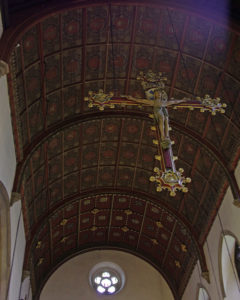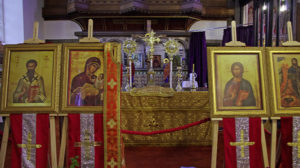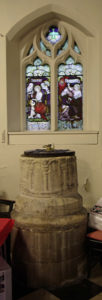St Peter at Gowts Church with its Norman tower is to the south of the city and next to the Norman “St Mary’s Guildhall.”:http://wasleys.org.uk/eleanor/presocialhistory/socialhistory/social/social/marys_guildhall/index.html Set among trees, it is not the easiest of buildings to photograph. The rather unusual name comes from the Great Gowt, a drainage ditch to the south of the Church.
During the Middle Ages this was an area of high status houses and many of Lincoln’s leading citizens lived here. During the C19th the railway arrived and the population increased rapidly. Streets of terraced houses were built and many of the properties along High Street had been turned into shops or inns.
The tower is the oldest part of the church and dates from the late C11th and is typical of the Saxo-Norman towers built in Lincolnshire, with the double window at the top. It is very similar to the tower of “St Mary Wigford”:http://wasleys.org.uk/eleanor/churches/england/lincolnshire/lincolnshire_three/lincoln_stmarywigford/index.html a short distance away. These are the oldest church towers in the city. It has the typical arrangement of long and short quoin corner stones. The west door into the church is more Saxon than Norman with a simple round arch and tympanum. There is a blocked Norman doorway on the south wall.
The original Norman nave and chancel were small and enlarged in the C13th and C14th. Only the south aisle survives as there was a major restoration in the C19th when the east end and north aisle were rebuilt. The Norman windows of the chancel were kept.
Entry is through the west door under the tower. The simple arch leading into the church is the oldest part of the building and is early C11th.
The font is at the back of the north aisle and is Saxo-Norman. It may have been made from a recycled Roman pillar as High Street is on the line of the Roman Fosse Way. It stands on a modern plinth.
It is a big church with and arcades of pointed arches separating the nave and side aisles. That on the south side is the original C13/14th. That on the north is C19th. The splendid memorial to the dead of World War One on a pillar of the south arcade was one of the last pieces of work Temple Moore completed before his death. It lists the names of 108 men and boys from the church and parish who died. Below is a single name from the Second World War.
There are some lovely stained glass windows in the south aisle. The king pin wooded ceiling in the nave is supported on stone corbels.
Steps lead up to the chancel with its splendid C19th carved stone reredos. This wasn’t painted until 1970. At the centre is Jesus Christ with St Paulinus, St Peter and the Virgin mary on the left. On the right are St John, St Andrew and St Hugh. Along the bottom are the smaller figures of the twelve apostles. At the centre are the crossed keys of St Peter. This motif is continued on the panels of the painted barrel ceiling. The rood cross suspended from the ceiling is also the work of Temple Moore. At the ends of the cross are the symbols of the four evangelists.
At the end of the south aisle is the Lady Chapel which was originally the chantry chapel of Ralph Jolif, a Lincoln merchant.
At the end of the north aisle is the Chapel of St Andrew, and this is used by the Greek Orthodox parish of St Basil the Great and St Paisos, who have been without a home for many years. They serve the Greek and Cypriot community in Lincoln and the surrounding areas, keeping the Greek language and customs alive. There are icons and beautiful monstrances on the altar. Behind the chapel is the vestry with the organ above it. The chapel also has a painted ceiling and there are old standards hanging from the walls.
I visited during the Heritage Open Days weekend when the church was being decorated for the World harvest festival, hence the assorted scarecrow like figures around the church. The church is usually kept locked although a key is available from St Peter at Gowts Primary School, a short walk away on Pennell Street.
There is some on street parking on High Street. The post code is LN5 7PY and the grid reference is SK 973704.
There are more pictures “here.”:http://wasleys.org.uk/eleanor/churches/england/lincolnshire/lincolnshire_three/lincoln_stpeter/index.html










